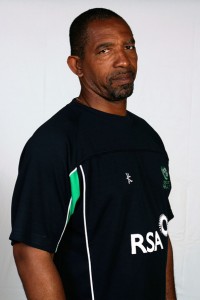
A gradual but inevitable descent into cricket-based loathing and bile.
Whatever Happened To The Unlikely Lads? #33: Steve Watkin
We like to think of ourselves as being open to criticism. We welcome helpful comments and feedback that enables us to improve. We even like to read the more enthusiastic threats and insults that come our way. And Plunkett, if you’re reading this: hello!
However in recent months we began getting repeat comments from one reader, who shall remain anonymous but whose IP-address we traced to a small house in the Canton area of Cardiff. His fire and passion for his cause shone through every message he sent us, so we thought we better do something to appease him – and we’re currently between solicitors. Therefore, hopefully in the future, we will no longer be bombarded with demands that every article needs “more Steve Watkin.”
It may seem remarkable now, but in the 1990s Glamorgan were actually a pretty decent county team. They had some success, spearheaded by such local luminaries as Isaac Vivian Alexander Richards and Waqar Younis (to this day, the pubs and clubs of Cardiff, Caerleon and Cwmfelinfach are full of songs about the latter). But at the core of that decade’s team was a bunch of decent county stalwarts who were good enough to be selected for England (and then dropped after about eight minutes). We’ve already looked at Hugh Morris and now, under our one Wales-related topic per year quota, we ask: whatever happened to
#33: Steven Llewellyn Watkin
There were some terrible terrible years for England (and Wales) in the 1990s, as we’re not slow to point out to the young pups complaining about Jonathan “ODI average of 52.66” Trott’s strike rate, or moaning that Steven “90 Test wickets by the age of 25” Finn gets hit for a few fours. However the summer of 1991 was not terrible at all. The series against the West Indies was a true classic and a 2-2 draw was an excellent result for England (and Wales) against what would remain the best team in the world for a few more years. In the first Test at Headingley, where Graham Gooch set up victory with the single greatest innings ever, Watkin was selected for his debut – not the first special horse for that particular course and certainly not the last – and took five wickets in the match. His dismissals of Carl Hooper, Richards and Gus Logie came in quick succession and left the visitors at 88/5 chasing 278. England (and Wales) opted not to change their attack for the second Test at Lord’s (not a common occurrence in the ’90s), and in a rain-affected draw he bowled just 15 wicketless overs – by way of comparison Derek Pringle bowled 35, Phil DeFreitas 31 and even Graeme Hick sent down 18 overs of gentle off-spin. By the third Test, Watkin was out of favour, replaced by Dermot Reeve in the squad and Richard Illingworth in the actual XI.
That looked to be it for Watkin, for over the next two years England (and Wales) handed debuts to eight more quick bowlers (of whom seven shared 21 caps; the other was Andrew Caddick) in ever more desperate attempts to beat Pakistan, India and Australia. But in the 1993 Ashes, Watkin reappeared on the selector’s radar of randomness. His call-up to the squad for the fifth Test at Edgbaston might have looked sensible, if it weren’t for the fact that 40-year old John Emburey was added to the mix 48 hours before the start of the game and took the Welshman’s rightful place. The pensioner took 3/150 in what was amazingly not his final Test. However Watkin did finally get another gig in the sixth and final match at the Oval.
And what a surprise result it was: England (and Wales)’s first victory over Australia for more than six years. With a target of 391 for victory (not insurmountable given their top six), Watkin removed Michael Slater, David Boon and Mark Taylor in his first spell, and added Ian Healy to his bag later. Some highlights of the match are here – including the only video footage in existence of Watkin, and what a fine ball to dismiss Paul Reiffel it is. His 4/65 (six wickets in the match) was able support to Man of the Match Angus Fraser and were enough to reward him with a tour to the West Indies that winter. He played the first ODI, but sadly for Wales (and England), back trouble kept him out of the team for the first Test and presented another opportunity to Alan Igglesden. Seriously, this was a weird time to be an English (or Welsh) cricket fan – especially when Watkin played three of the four ODIs that were sandwiched between the first and second Test.
He was a good enough county bowler to win the PCA Player of the Year Award in 1993 and was the only non-Australian to be a Wisden Cricketer of the Year the following spring. He was the perfect definition of a traditional English Welsh seamer. Indeed, a look at his annual first-class hauls shows his true worth:
- 1988, 46 wickets
- 1989, 94 wickets
- 1990 (the year of the bat), 69 wickets
- 1991, 74 wickets
- 1992, 68 wickets
- 1993, 92 wickets
- 1994, 55 wickets
- 1995, 65 wickets
- 1996, 67 wickets
- 1997, 61 wickets (we could go on, he took at least 40 first-class wickets every season until his retirement in 2001)
Although the likes of DeFreitas, Fraser and Devon Malcolm – and later Caddick and Darren Gough – were good enough to keep Watkin out of the team, the fact that so many other lesser seamers came and went in this era suggests that the Welshman was unlucky not to have had a longer stint in on the international scene. And no doubt that when he was omitted cries from the Valleys sang out, “more Steve Watkin!”




1 Comment
Post a Comment
1
Nichael Bluth
31 Jul 2013 03:50
Needs more Steve Watkin.